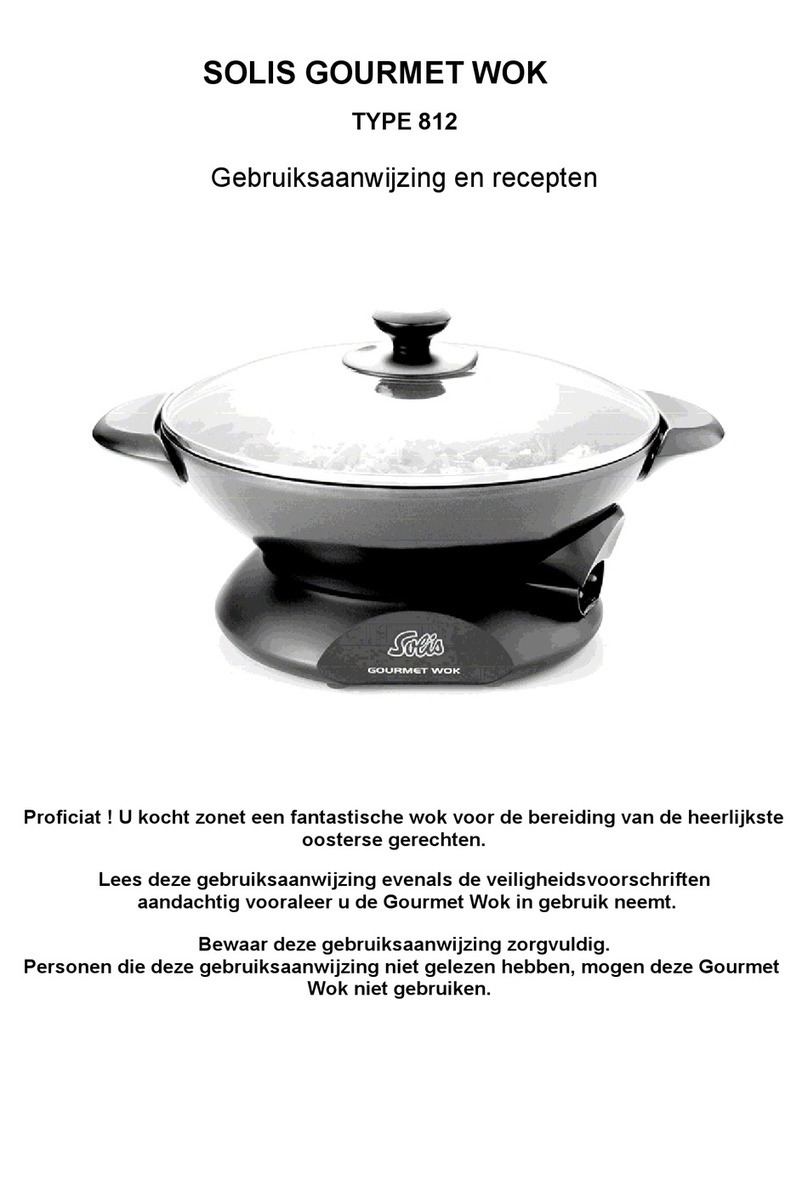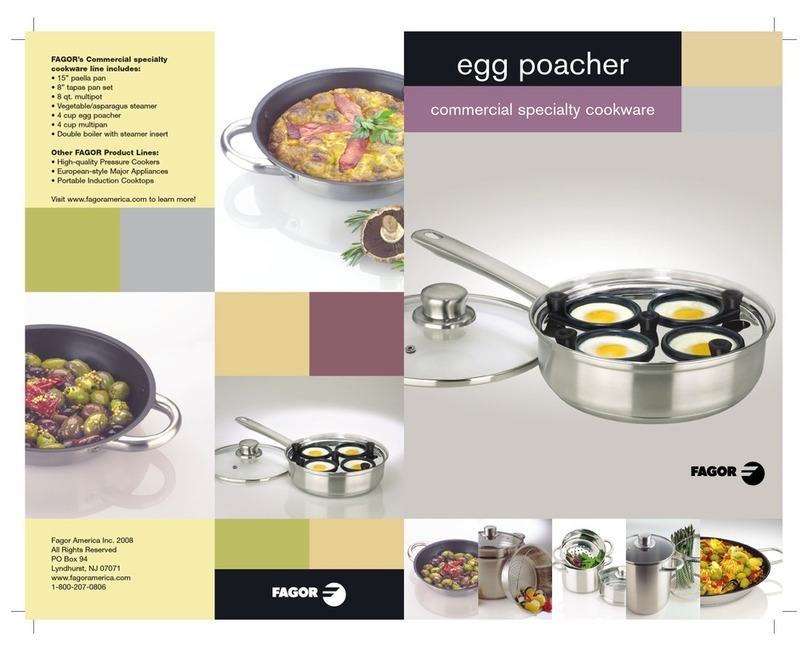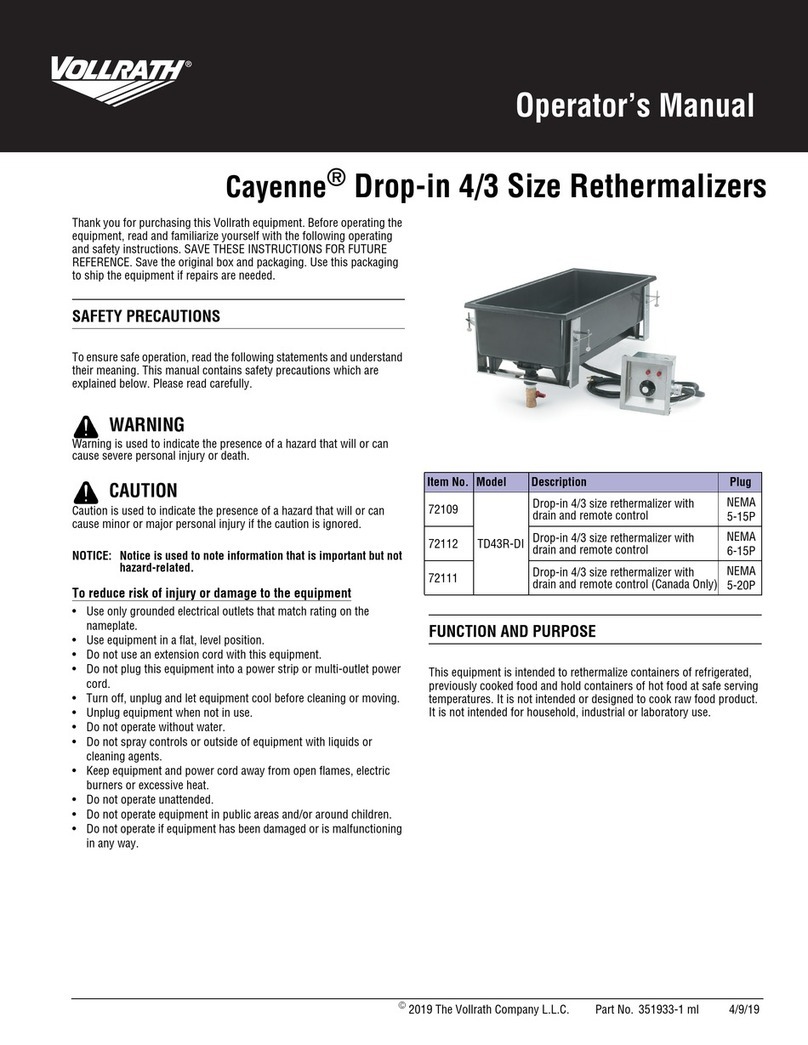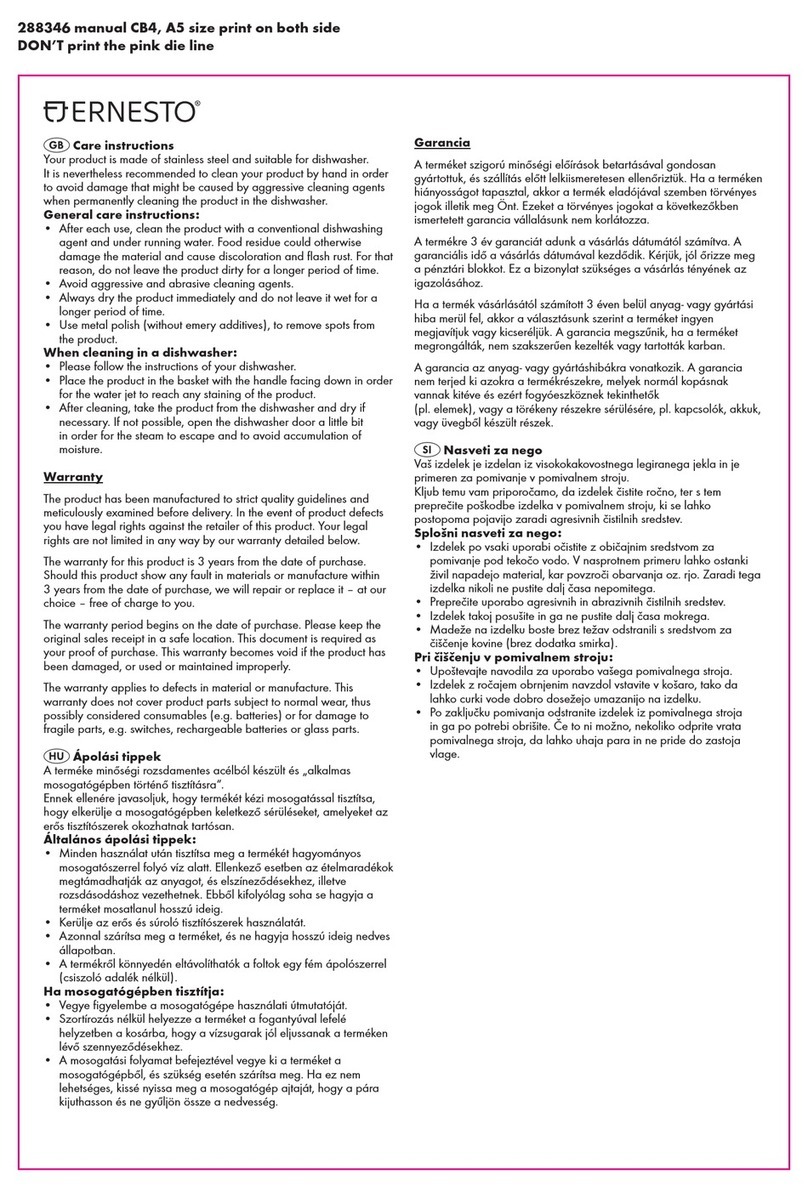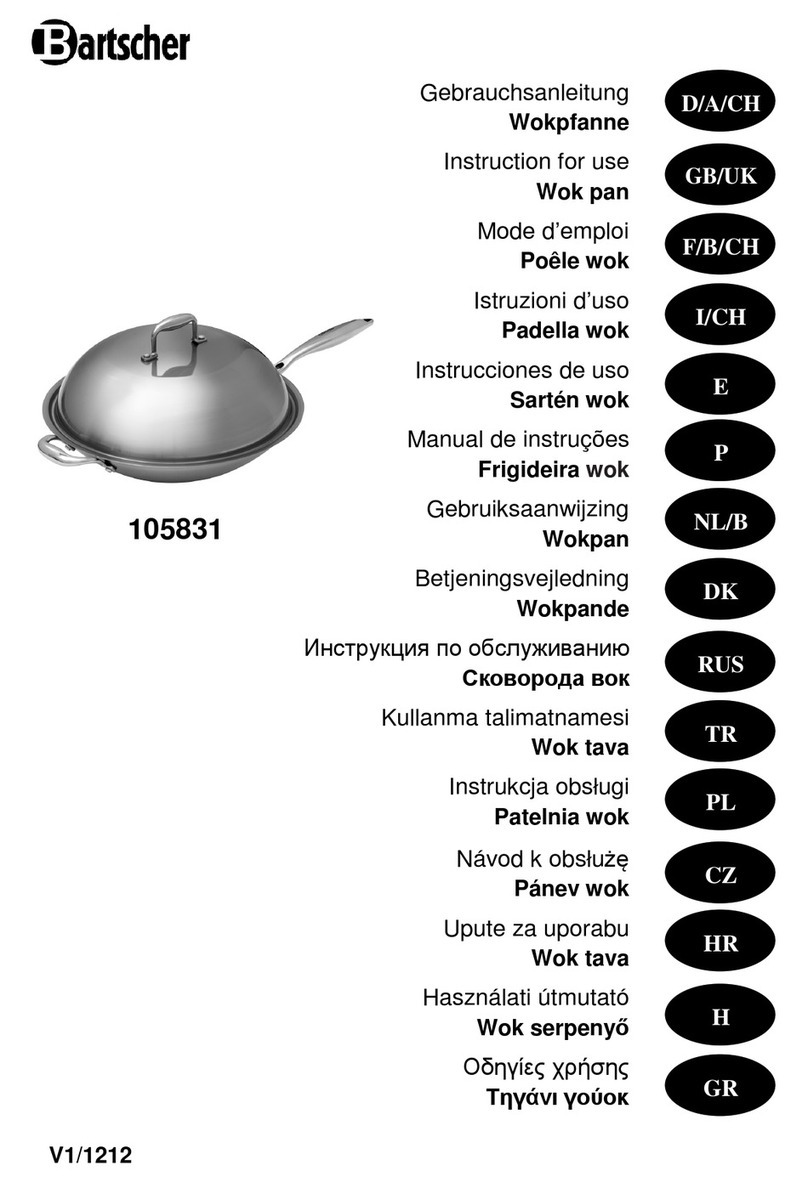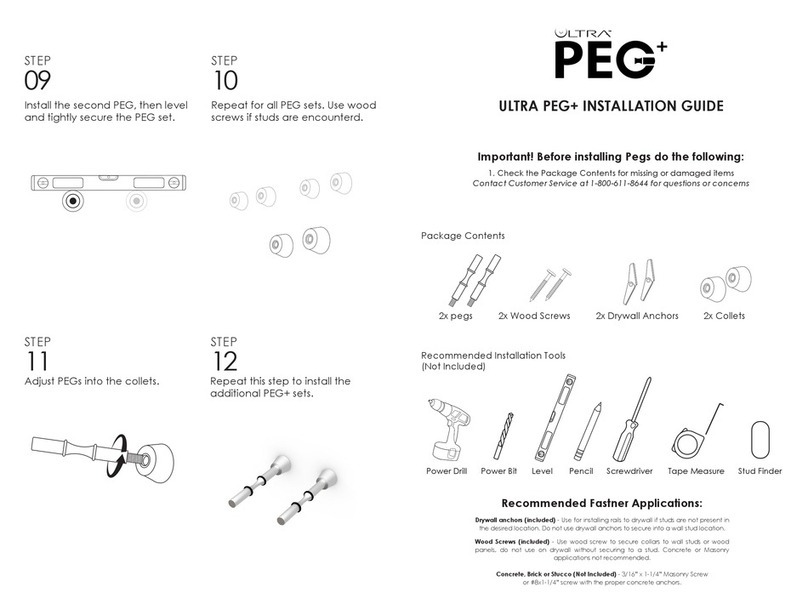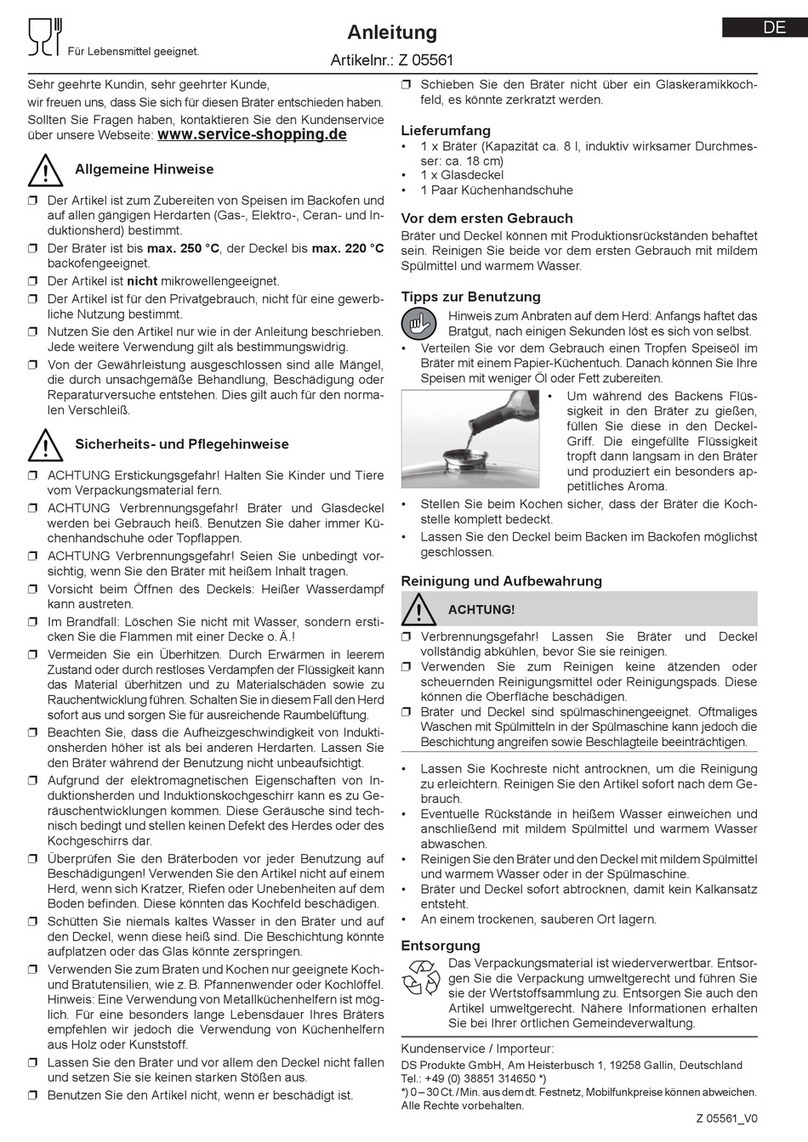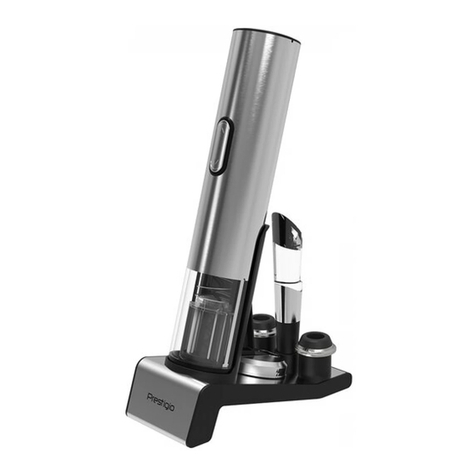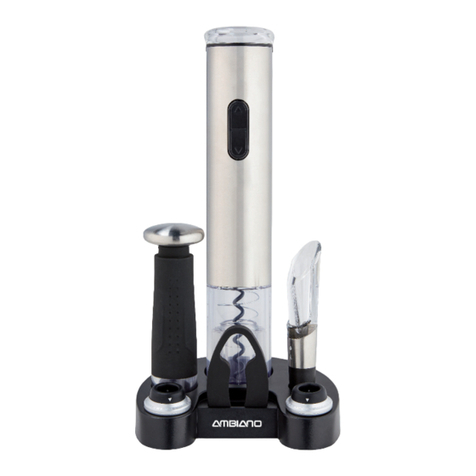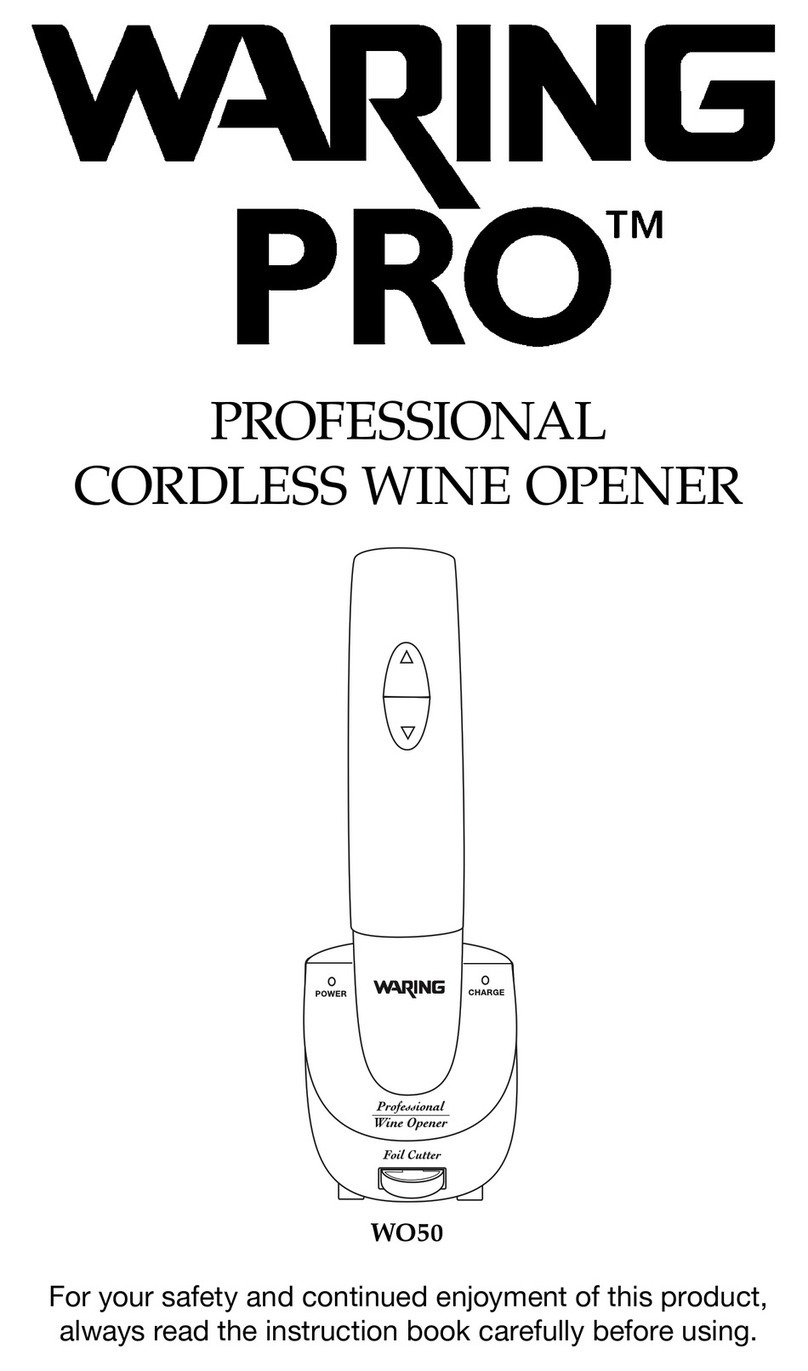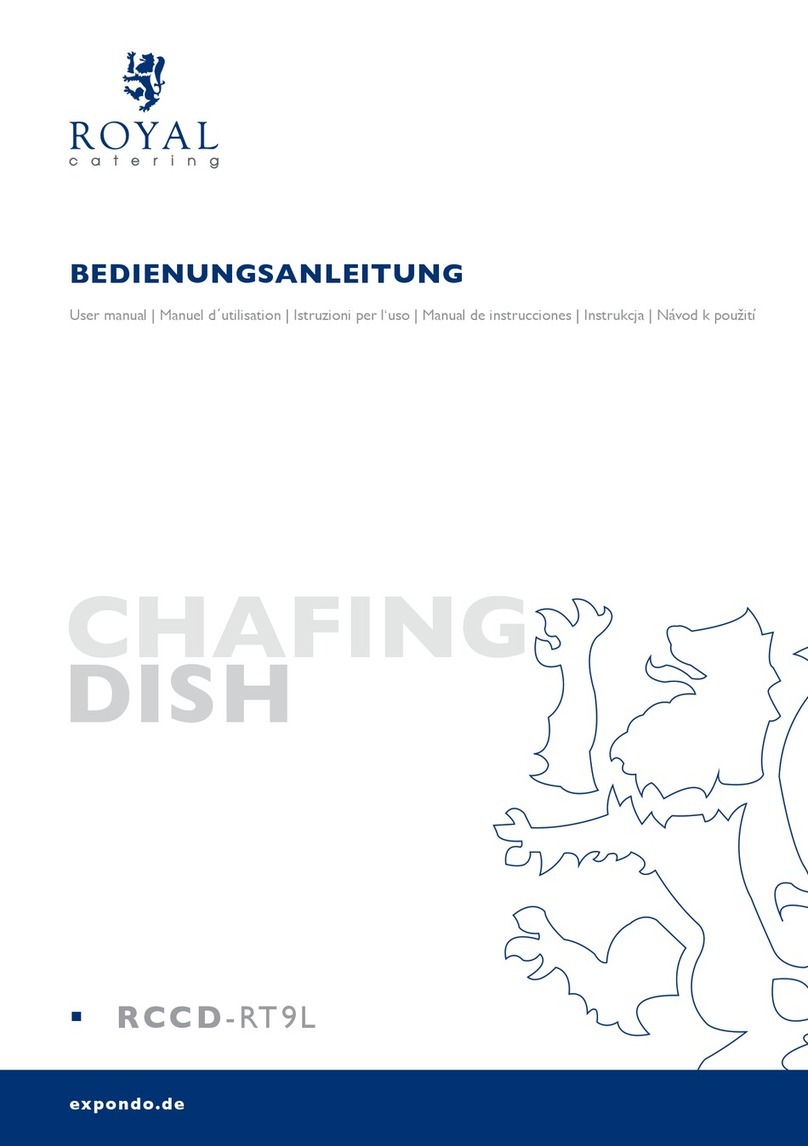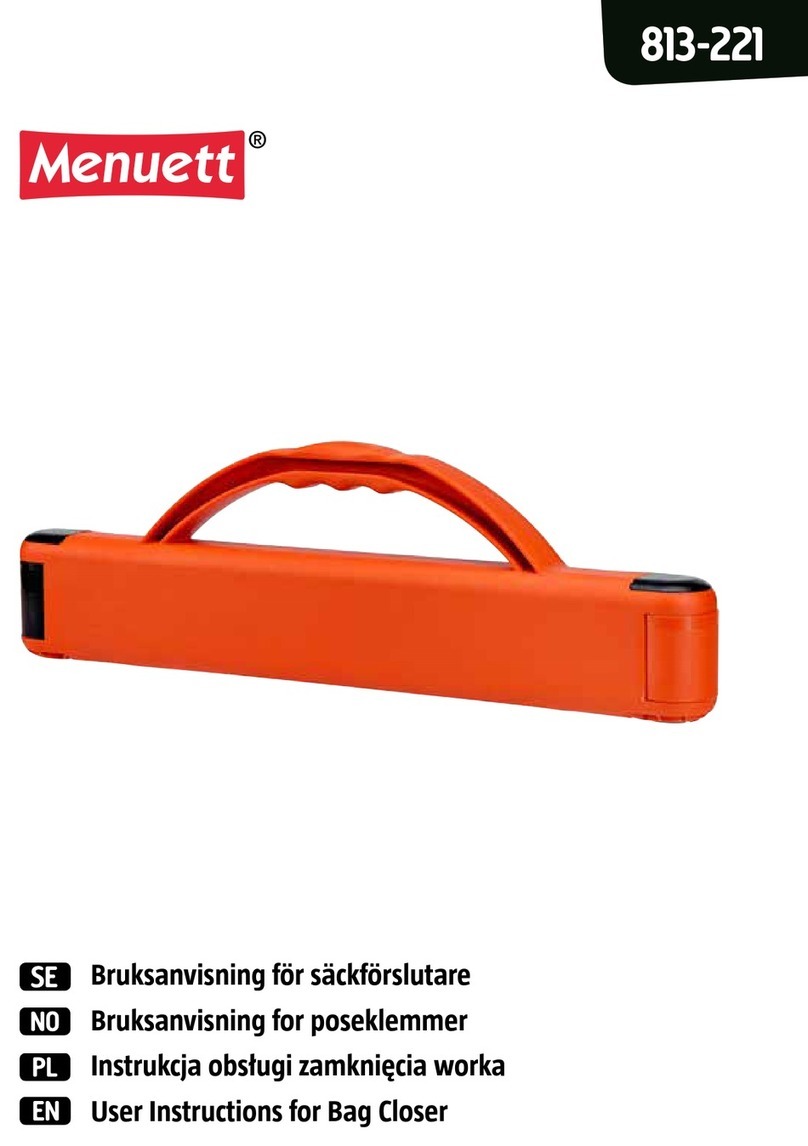Breville HealthSmart BEW300 User manual

HealthSmart® Wok
Instructions
BEW300

2
Page
Introduction 3
Breville recommends safety first 4
Know your Breville Wok 6
Operating your Breville Wok 8
Care and Cleaning 9
Cooking Techniques 12
Stir Frying 12
Steaming 13
Shallow Frying 14
Slow Cooking 14
Preparation Techniques 15
Special Ingredients 16
Recipes R1
Contents

3
Congratulations
on the purchase of your new Breville HealthSmart™ Wok

4
We at Breville are very safety conscious. We design and manufacture consumer products with the
safety of you, our valued customer, foremost in mind. In addition we ask that you exercise a degree
of care when using any electrical appliance and adhere to the following precautions.
IMPORTANT SAFEGUARDS FOR YOUR BREVILLE WOK
Carefully read all instructions before
operating the appliance and save for future
reference.
Remove and safely discard any packaging
material and promotional labels before using
the appliance for the first time.
To eliminate a choking hazard for young
children, remove and safely discard the
protective cover fitted to the power plug of
this appliance.
Do not place the appliance near the edge
of a table, counter or bench top during
operation. Ensure the surface is level, clean
and free of water.
Do not use the Wok on a sink drain board.
Do not place this appliance on or near a
hot gas or electric burner, or where it could
touch a heated oven.
Keep the appliance clear of walls, curtains
and other heat sensitive materials. Minimum
20cm distance. Provide adequate space
above and on all sides for air circulation
around the Wok.
On surfaces where heat may cause a
problem, an insulating mat is recommended.
Always ensure the Wok is properly
assembled before use. Follow the
instructions provided in this book.
Always insert the Temperature Control Probe
into the appliance first, then insert power
plug into the power outlet.
Do not use any other temperature control
probe or connector. The Wok must be used
with the Temperature Control Probe provided.
The appliance is not intended to be operated
by means of an external timer or separate
remote control system.
•
•
•
•
•
•
•
•
•
•
•
•
Ensure the Wok is completely dry and free of
water before adding any oil. When shallow
frying, ensure water does not come in
contact with hot oil as this will cause the oil
to bubble and splatter.
Always add the required amount of oil to the
Wok before switching the power on at the
power outlet.
Avoid the use of extension cords. Serious
hot oil burns may result from a Wok being
pulled off a bench top. Do not allow the cord
to hand over the edge of a bench top where
it may be grabbed by children, or become
entangled by the user. Never leave the Wok
unattended while in use.
Do not leave the appliance where children
can touch hot surfaces, power cord or any
other part of the Wok.
Do not touch hot surfaces. Use handles.
Allow the temperature control probe to cool
before removing from the Wok.
Do not use metal utensils. Use suitable sized
heat-proof plastic or wooden utensils to stir
or remove food.
Extreme caution must be used when using
the Wok for shallow frying or when filled with
other liquids. Do not move the Wok during
cooking and allow it to cool before removing
oil used for shallow frying.
Always lift the lid away from you, when
removing from Wok, to avoid steam escaping
from under the lid.
Do not place anything on top of the Wok
when the lid is in position, when in use and
when stored.
•
•
•
•
•
•
•
•
•
Breville recommends safety first

5
Always turn the temperature control probe
to ‘MIN’, switch the power off at the power
outlet and remove the power plug then allow
the Wok, lid and the temperature control
probe to cool before attempting to move
the appliance, when the appliance is not in
use and before disassembling, assembling,
cleaning and storing.
Do not use harsh abrasives, caustic cleaners
or oven cleaners when cleaning this
appliance.
Keep the Wok clean. Follow the cleaning
instructions provided in this book.
IMPORTANT SAFEGUARDS FOR
ALL ELECTRICAL APPLIANCES
Fully unwind the power cord before use.
Do not let the power cord hang over the edge
of the table, counter or bench top, touch hot
surfaces or become knotted.
To protect against shock, do not immerse
the power cord, power plug or appliance in
water or any other liquid.
This appliance is not intended for use by
persons (including children) with reduced
physical, sensory or mental capabilities,
or lack of experience and knowledge
unless they have been given supervision or
instruction concerning use of the appliance
by a person responsible for their safety.
Do not leave the appliance unattended when
in use.
Children should be supervise to ensure that
they don’t play with the appliance.
This appliance is for household use only.
Do not use this appliance for anything other
than its intended use. Do not use in moving
vehicles or boats. Do not use outdoors.
It is recommended to regularly inspect the
appliance. Do not use the appliance if the
power cord, plug or appliance becomes
•
•
•
•
•
•
•
•
•
•
•
Breville recommends safety first continued
damaged in any way. Return the entire
appliance to the nearest authorized Breville
Service Centre for examination and/or repair.
Any maintenance other than cleaning should
be performed at an authorised Breville
Service Centre.
The installation of a residual current device
(safety switch) is recommended to provide
additional safety protection when using
electrical appliances. It is advisable that a
safety switch with a rated residual operating
current not exceeding 30mA be installed in
the electrical circuit supplying the appliance.
See your electrician for professional advice.
•
•

6
2200 Watt Die-cast Butterfly
The butterfly shaped element in your Breville Wok
creates a heat zone over the entire Wok surface. The
construction of the Wok bowl is designed to retain
even heat and save energy.
Know your Breville Wok
Setting Function Heat Setting Guide
MIN - 4 Keep food warm, slow cooking sauces,
very slow simmering
Low heat/slow cook
5-6 Curries, casseroles, pasta, rice, browning
nuts, steaming foods
Medium heat
7 - HIGH SEAR Shallow frying, sealing meat, stir frying High heat
Non-Stick Cooking Surface
Your Breville Wok features a non-stick
cooking surface ensuring that foods will
not stick and less oil can be used while
cooking. Regular high heat cooking may
discolour the non-stick surface; this is
normal and will not affect the performance
of the non-stick coating. Only suitable
heat-resistant plastic or wooden utensils
should be used to avoid the surface being
scratched.
Quick Release Removable Base
Your Breville Wok has a Quick Release Removable
Base for easy cleaning. This allows the Wok bowl
to fit easily into the dishwasher or sink. The Quick
Release Removable Wok Base is not dishwasher
safe (see page 9).

7
Know your Breville Wok continued
Cook ‘n’ Look Glass Lid with adjustable steam
vent
With the Cook ’n’ Look Glass Lid in position, the
Breville Wok can be used for making curries and
casseroles. Use the Adjustable Steam Vent located
under the handle to release excess steam build up
during slow cooking or to reduce liquids.
Note: Recipes using the lid have the vent closed
unless otherwise stated in recipe.
Setting Function Heat Setting Guide
MIN - 4 Keep food warm, slow cooking sauces,
very slow simmering
Low heat/slow cook
5-6 Curries, casseroles, pasta, rice, browning
nuts, steaming foods
Medium heat
7 - HIGH SEAR Shallow frying, sealing meat, stir frying High heat WARNING: NEVER IMMERSE THE TEMPERATURE CONTROL PROBE OR POWER CORD IN WATER OR
ANY OTHER LIQUID.
Removable Temperature
Control Probe
The Temperature Control Probe
Dial has 10 heat settings for
accurate heat control. The
thermostat light on the probe
switches off automatically when
the heat setting temperature is
reached and will cycle on and off
during cooking, maintaining the
heat setting temperature selected.
The numbers on the Temperature
Control Probe Dial represent
the heat setting temperatures
approximately (shown below).
Heat Setting Guides given are a guide only and
may require adjustment to suit various foods
and individual tastes.

8
Before first use
Remove and safely discard any promotional
packaging material and labels from the Wok.
Quick Release Removable Base can be
removed for easy cleaning (see page 10).
Wash the Wok bowl, base and lid in hot soapy
water. Rinse and thoroughly dry. The
Do not immerse the power cord and/or
Temperature Control Probe in water or any
other liquid.
Before inserting the Temperature Control Probe
into the Wok socket ensure the interior of the
socket is completely dry. To do this, shake
out excess water then wipe the interior of the
socket with a dry cloth.
Operating the Breville Wok
Position the Wok on the Quick Release
Removable Base, ensuring the Wok is firmly
located on the base tray and the base is
locked into position.
Insert the Temperature Control Probe into
the socket at the side of the Wok. Always
insert the Temperature Control Probe into the
appliance first, then insert the power plug
into the power outlet.
Insert the power plug into a 230/240V power
outlet and switch on.
Turn the Temperature Control Probe Dial
to Setting HIGH SEAR and allow the Wok
to preheat for approximately 5 minutes.
The thermostat light will illuminate as it is
aligned with the selected setting indicating
the Wok is heating.’
When the Wok has reached the selected
heat setting temperature the thermostat
light will go out. The Wok is now ready for
use. The thermostat light will cycle on and
off throughout cooking as the heat setting
temperature is maintained by the thermostat.
1.
2.
3.
4.
5.
Operating your Breville Wok
Add food as directed in the recipes. Do not
leave plastic cooking utensils in contact with
the Wok while cooking.
When cooking has finished, turn the
Temperature Control Probe Dial to the ‘MIN’
position on dial, before switching off at the
power outlet. Unplug the power cord from
power outlet and leave the Temperature
Control Probe inserted in the appliance until
cool.
WARNING: NEVER OPERATE THE WOK
WITHOUT THE QUICK RELEASE REMOVABLE
BASE CORRECTLY POSITIONED.
The Wok must be used with the Temperature
Control Probe provided. Do not use any other
temperature control probe or connector.
When stir frying or when a high heat is required,
set the Temperature Control Probe Dial to
Setting HIGH SEAR and allow thermostat light
to cycle on and off several times. This will
allow the cooking surface to adjust to a more
accurate cooking temperature.
Never place oil or food into a cold Wok while it
is heating, this will give a poor cooking result.
Allow the correct temperature to be reached
before adding food.
WARNING: THE WOK GETS VERY HOT
DURING USE, ALLOW ALL PARTS TO COOL
BEFORE MOVING, DISMANTLING, CLEANING OR
STORING.
6.
7.

9
Before cleaning, turn the Temperature
Control Probe Dial to MIN, switch the Wok
off at the power outlet and unplug from the
power outlet.
Allow the Wok to cool completely before
cleaning.
Remove the Temperature Control Probe from
the socket of the appliance.
•
•
•
Care, Cleaning and Storage
TEMPERATURE CONTROL PROBE
Cleaning:
If cleaning the Temperature Control Probe and
power cord is necessary, wipe with a slightly
damp cloth and dry thoroughly.
Do not immerse the power cord, power plug or
Temperature Control Probe in water or any other
liquid.
Storage:
Store the Temperature Control Probe carefully.
Do not knock or drop the probe as this can
cause damage. If damage is suspected, return
the entire appliance including the Temperature
Control Probe to your nearest Breville Service
Centre for inspection and/or repair.
For convenient storage of the Temperature
Control Probe, line the Wok bowl with two
sheets of kitchen paper and place the probe on
the kitchen paper. This will ensure the probe
and plug do not scratch the non-stick surface.
WARNING: THE WOK GETS VERY HOT
DURING USE, ALLOW ALL PARTS TO COOL
BEFORE MOVING, DISMANTLING, CLEANING OR
STORING.

10
QUICK RELEASE REMOVABLE
BASE
Your Breville Wok has a Quick Release
Removable Base for easy cleaning. The Wok
bowl is dishwasher safe. The removable Wok
base is not dishwasher safe and should be
wiped over with a damp cloth, or washed in
warm soapy water, rinsed and dried thoroughly.
To remove the base for cleaning
Turn the Wok upside down (as illustrated
below). Turn the knob in the centre of the
base anti-clockwise to release, as shown by
the arrow.
Lift the base from the Wok, lifting over the
Temperature Control Probe socket.
The Quick Release Removable Base may
be wiped clean or washed with warm
soapy water, rinsed then dried thoroughly.
The Quick Release Removable Base is not
dishwasher safe - only the Wok bowl is
dishwasher safe. Ensure the removable Wok
base is completely dry before re-attaching to
the Wok bowl.
1.
2.
3.
NON-STICK SURFACE
Cooking on a non-stick surface minimises the
need for oil, food does not stick and cleaning is
easier. Any discolouration that may occur will
only detract from the appearance of the Wok
and will not affect the cooking performance.
Do not use sharp objects or cut food inside
the Wok. Breville will not be liable for damage
to the non-stick coating where metal utensils
have been used. Use suitable heat proof
plastic or wooden utensils.
Cleaning:
When cleaning the non-stick surface and
exterior of the Wok do not use metal (or other
abrasive) scourers. Wash in hot soapy water.
Remove stubborn spots with a plastic washing
pad or nylon washing brush. Rinse and dry
thoroughly.
Storage:
Do not store any sharp or metal objects on the
non-stick surface.
Care, Cleaning and Storage continued

11
Care, Cleaning and Storage continued
Reposition base to Wok, push down on the
quick release knob and turn clockwise to
lock.
Storage:
The Quick Release Removable Base should be
completely assembled on the Wok bowl before
storing.
WARNING: THE WOK SHOULD NEVER
BE OPERATED WITHOUT THE WOK AND BASE
COMPLETELY ASSEMBLED WITH THE BASE
LOCKED INTO POSITION.
4. COOK ‘N’ LOOK GLASS LID
Wash the glass lid in warm soapy water using
a soft cloth, rinse and dry thoroughly. The glass
lid is dishwasher safe.
Take care when the glass lid is hot. Do not place
hot lid under cold water or on cold surfaces.
This may cause the lid to break.
WARNING: THE GLASS LID HAS BEEN
SPECIALLY TREATED TO MAKE IT STRONGER,
MORE DURABLE AND SAFER THAN ORDINARY
GLASS. HOWEVER IT IS NOT UNBREAKABLE.
IF DROPPED OR STRUCK EXTREMELY HARD,
IT MAY BREAK OR WEAKEN, AND COULD AT
A LATER TIME, SHATTER INTO MANY SMALL
PIECES WITHOUT APPARENT CAUSE.
Dishwasher safe
Your Wok bowl is dishwasher safe for easy
cleaning. Both the Wok bowl and lid may be
placed in the dishwasher. The removable Wok
base and Temperature Control Probe should not
be placed on the dishwasher.
Before inserting the Temperature Control Probe
into the Wok socket ensure the interior of the
socket is completely dry. To do this, shake
out excess water then wipe the interior of the
socket with a dry cloth.

12
Stir frying
Stir frying should be carried out using a high
heat setting. Recommend to use Temperature
Control Probe setting 8 to HIGH SEAR for stir
frying meat and use setting 8 for vegetables
and seafood.
Stir frying is an energy efficient and healthy
way of cooking foods. The benefit of this
method is its speed and the flavour result. The
non-stick cooking surface on your Wok also
means that less oil is required for cooking.
The cooking action for stir frying is a continual
tossing motion to ensure the food is evenly
exposed to the heat and cooks quickly and
evenly in a couple of minutes.
To stir fry foods, follow the following procedure:
Preheat the Wok before adding any
ingredients; allow the thermostat light
to cycle ‘on’ and ‘off’ several times. This
will allow the Wok to reach an even high
temperature.
Stir frying is a dry heat cooking method and
is suited to tender cuts of meat. Quickly stir
and toss the food to be cooked in batches.
Avoid over cooking. Timing is a key factor
when stir frying as over cooking will give a
tough, dry result. Cooking times depend on
the size and thickness of the cut of meat,
chicken, etc. as the larger the cut the more
time is needed.
Recommended cuts for stir frying
Beef: lean beef strips prepared from rump,
sirloin, rib eye and fillet.
Chicken: lean chicken strips prepared from
breast fillets, tenderloins, thigh fillets.
Lamb: lean lamb strips prepared from fillet,
lamb leg steaks, round or topside mini roasts
and loin.
Pork: lean pork strips prepared from leg,
butterfly or medallion steaks or fillet
Veal: eye of loin, fillet, round, rump or topside.
1.
2.
3.
Stir fry tips
Buy meat strips from your butcher or
supermarket, or prepare meat strips from
recommended cuts by removing any fat
and slicing thinly across the grain (across
direction of meat fibres).
Slicing across the grain optimises
tenderness. Cut into very thin strips,
approximately 5 to 6cm in length. Partially
freeze meat (approximately 30 minutes) to
make slicing easier. Ensure meat strips are
fully defrosted before cooking
Stir fry meat strips in small batches (approx
200 - 300g) to stop meat releasing juice and
‘stewing’, avoiding tougher meat results.
When adding meat strips to the Wok, the
strips should sizzle on the non-stick surface.
Stir fry meat strips for 1 - 2 minutes. Any
longer cooking may toughen meat.
Remove each batch when cooked and allow
Wok to reheat before stir frying the next
batch. By cooking in small batches the heat
of the Wok remains constant, ensuring the
meat does not release juices and toughen.
A small amount of oil can be mixed through
the meat strips before adding to the Wok,
together with any other flavouring such as
garlic, ginger and chilli. A little sesame oil
can also add flavour. Mixing the meat with
the oil rather than heating the oil separately
in the Wok eliminates using too much oil.
Drain thin marinades from meat strips before
stir frying to prevent stewing and splatter.
Peanut oil is traditionally used for stir fry
Asian style dishes. However other oils such
as vegetable, canola and light olive may be
used.
Do not over fill the Wok. If necessary cook in
batches and reheat at the end of stir frying.
If using this method remember to under cook
slightly to not overcook the end result.
Serve stir fried foods immediately to retain
their crisp texture.
•
•
•
•
•
•
•
•
•
•
•
Cooking Techniques

13
Stir fry vegetables, after searing the meat, in
a little oil (or sprinkling of water) until vivid in
colour for:
3 minutes Onion, quartered
Broccoli, flowerets
Carrots, sliced
Soaked Chinese dried
mushrooms
2 minutes Snow peas
Capsicum, sliced
Zucchinis, sliced
Water chestnuts
Bamboo shoots
1 minute
This brief cooking
time will keep
vegetables crisp.
Garlic, minced
Chilli, minced
Ginger, minced
Shallots, chopped
Bean sprouts
•Steaming
Recommended temperature probe setting 4-5.
Steamed foods are tender and juicy and retain
most of their nutritional value when cooked in
the Wok.
To steam foods, follow the following procedure:
Add approximately 2 cups of water or stock
to the Wok. Place a suitable sized steaming
rack into the Wok. Liquid should not cover
the rack. Cover with lid.
Preheat Wok on heat setting 4 - 5 until liquid
simmers. Remove the lid.
Place foods to be steamed on the steaming
rack.
Cover Wok with lid and simmer until food is
cooked as desired.
A steaming rack is not included with this
product and will need to be purchased
separately.
Steaming tips
If using a metal rack take care not to scratch
the non-stick surface.
Do not allow the water or stock to touch the
rack or food.
Check liquid level occasionally. Add more hot
water if further steaming is required.
Always lift the lid away from you, when
removing from Wok, to avoid steam escaping
from under the lid.
1.
2.
3.
4.
•
•
•
•
Cooking Techniques continued

14
Cooking Techniques continued
Shallow frying
Recommended temperature probe setting 8
– HIGH SEAR.
Shallow fried foods are crisp on the outside
and tender and juicy inside when cooked in the
Wok.
To shallow fry foods, follow the following
procedure:
Place approximately 1 cup or sufficient
amount of oil into the Wok so that only half of
the food is immersed.
Heat oil on setting 8 - HIGH SEAR until
temperature is reached.
Shallow fry foods in small batches
Shallow frying tips
When shallow frying, use a small amount of
oil to crispen and cook foods.
Preheat the oil before adding food. Never
cover with the lid during heating or cooking
with oil as this will cause condensation
(water droplets) to drip into the oil and result
in bubbling and splattering.
Do not move the Wok during heating or
cooking with oil.
Wipe any moisture from foods before adding
to Wok to avoid splattering.
Cook a few pieces of food at a time to
ensure crispness.
Drain cooked foods on kitchen paper to
absorb oil.
Never leave the Wok unattended or
unsupervised while shallow frying.
Allow oil to cool completely before removing
from the Wok.
Vegetable, peanut or canola oil is
recommended for shallow frying.
1.
2.
•
•
•
•
•
•
•
•
•
•
Slow cooking (braising)
Recommended temperature probe setting 2-4.
The Breville Wok is ideal for cooking curries
and casseroles by allowing less tender meat
cuts to be used to obtain a tender result. Less
tender meat cuts contain sinew and gristle;
these will be broken down during cooking to
give a tender result. It is not recommended to
cook casseroles and curries with tender meat
cuts as they will toughen and shrink during
cooking.
It is recommended during slow cooking to
place the lid onto the Wok to retain heat. During
the cooking process the curry or casserole will
boil then cycle off to maintain the temperature.
This is normal operation for a probe controlled
appliance.
Recommended cuts for slow cooking
(braising)
Beef: diced blade (boneless), chuck, round,
shin, silverside, gravy beef
Chicken: diced thigh, leg
Lamb: diced forequarter, shanks and neck
chops
Veal: diced forequarter, leg and knuckle (osso
bucco)
Pork: diced forequarter, leg
Slow cooking (braising) tips
Cut meat into 3cm cubes. Trim any visible
fat.
Use a medium to low heat setting
Cook for approximately 1½ - 2 hours, stirring
occasionally with the lid in position.
Add soft or quick cooking vegetables such as
mushrooms, tomatoes, beans or corn in the
last half hour of cooking.
Thicken towards end of cooking by stirring
a little cornflour blended with water, or
plain flour blended with margarine or butter.
Alternatively, coat meat in plain flour before
frying (extra oil may be needed).
•
•
•
•
•

15
Cooking Techniques continued
Preparation techniques
The success of any dish depends on planning
and preparation. To achieve an authentic
Oriental appearance for Wok cooking and
even cooking results, food should be cut into
small, even sized pieces. This allows food to
cook quickly and to be easily picked up with
chopsticks.
Slicing
A straight or diagonal slice can be used for
cutting meats and vegetables. Slices should
be of an even thickness. Partially frozen meat
will slice more evenly. Slice meat very thinly,
across the grain to obtain a more tender result.
Defrost meat fully before cooking
Matchstick or julienne
Trim and straight cut suitable vegetables, such
as carrots, into matchstick length pieces. Cut
these pieces lengthwise then stack slices and
cut again into thin or thick sticks depending on
the recipe.
Shredding
Used for cutting meats and vegetables. 5mm
slices of food should be rolled or stacked, then
cut again into 5mm sticks. Vegetables such as
cabbage and spinach should have their leaves
stacked, then rolled up. Cut width ways very
finely.
Cubing and dicing
Used for cutting meats and vegetables. To
cube, cut 3cm slices, then stack them on top
of one another and slice 3mm thick in the
opposite direction. Cut again in the opposite
direction forming 3cm cubes. To dice, follow
the same directions, making 5mm slices
forming 5mm cubes.
Planning ingredients ahead makes stir frying
easier.

16
Special Ingredients
Agar-agar
This convenient product can be purchased in
fine sheets and is made from different types
of seaweed. It has excellent setting properties,
similar to gelatine, and will set at room
temperature.
Bok choy
Also known as Chinese chard or Chinese white
cabbage, bok choy has fleshy white stems and
dark green leaves with a slight mustard taste.
There is also a smaller version called Shanghai
or baby bok choy.
Bamboo shoots
The young tender shoots of bamboo plants
are available in cans from the supermarket
or Asian grocery stores. Bamboo shoots are
mainly used to add texture to dishes.
Coconut cream and coconut milk
Both coconut cream and milk are extracted
from the grated flesh of mature coconuts. The
cream is a richer first pressing and the milk the
second or third pressing. Low-fat products are
also available and can be readily substituted in
recipes.
Chillies, fresh and dried
Chillies are available in many different types
and sizes. Small chillies (birds eye or bird
peppers) are the hottest. Use tight fitting gloves
when handling and chopping fresh chillies
as they can burn your skin. The chilli seeds
are the hottest part of the chillies so remove
them if you want to reduce the heat content of
recipes.
Crisp fried shallots
These are available pre prepared from most
Asian grocery stores and supermarkets.
Char siu sauce
This is the equivalent of Chinese barbecue
sauce.
Coriander
Also known as cilantro and Chinese parsley,
it is an essential in many southeast Asian
cuisines. A strongly flavoured herb, use it
sparingly unless accustomed to the unique
flavour. Parsley can be substituted and
although it looks similar, parsley tastes quite
different. Coriander is available as a fresh
green herb and also as a ground spice and in
seed form.
Fish sauce
A thin, salty dark brown sauce with a
distinctive fishy smell, used extensively in Thai
and Vietnamese cookery, it is made from small
fish that have been fermented in the sun. Fish
sauce replaces salt in many recipes.
Garam marsala
A blend of spices, usually consisting of a
combination of cinnamon, cumin, pepper,
cloves, cardamom, nutmeg and mace. It can
be bought already blended from supermarkets,
but it is best freshly made. It is usually added
towards the end of cooking.
Green ginger wine
An Australian made alcoholic sweet wine
infused with ginger.
Hoisin sauce
This sauce is a thick sweet Chinese barbecue
sauce made from a mixture of salted black
beans, onions and garlic.
Hoikkien noodles
These noodles, made from wheat flour, are
thick, yellow and firm in texture and are cooked
and lightly oiled before being packaged. The
noodles need to be separated before cooking

17
Rice noodles
These are fresh white noodles and do not
require a lot of cooking.
Kaffir lime leaves
These are dark green, shiny, double leaves
which have a very pungent perfume. They are
rather thick and added whole to a curry or
sliced very finely for use as a garnish.
Lemon grass
An aromatic fresh herb that is used in curry
pastes, stir fries and soups. Trim the base,
remove the tough, outer layers and finely slice,
chop or pound the white interior. Whole stems
can be added to soups or curries.
Lychees
Delicious, small round fruit with a light texture
and flavour. Peel away the rough skin, remove
the seed and use. They are also available
peeled and canned.
Rice wine vinegar
Milder than most western vinegars, it usually
has an acidity of less than 4%. It has a mild,
sweet, delicate flavour and is made from rice.
Sambal oelek
This is a paste made from ground chillies and
salt. It can be used as an ingredient or an
accompaniment.
Tamarind
Tamarind is a large, brown bean-like pod with
a fruity, tart flavour and is available as a dried
shelled fruit, a block of compressed pulp or as
a puree or concentrate.
Szechuan pepper corns
These are available from most Asian
supermarkets and have a slight aniseed taste.
Tofu
Tofu, or bean curd, is a high-protein, low-fat
food made from soya beans. It is available in
very firm or soft blocks and is either fresh or
vacuum packed. Tofu takes on the flavour of
the spices and sauces with which it is cooked
Turmeric
This is best known in its powdered form and is
often used to colour food. It has a slightly bitter
flavour and it is also available fresh as a root,
rather like ginger, which is peeled and then
grated and finely chopped.
Water chestnuts
Small, white, crisp bulbs with a brown skin.
Water chestnuts can be purchased peeled
and canned, and will keep for about 1 month,
covered in the refrigerator.
Special Ingredients continued

R1
Recipes

R2 NOTE: ALL RECIPES USE AUSTRALIAN STANDARD MEASURING CUPS AND SPOONS.
Contents
Page
Appetisers, entrees and soups R3
Stir fries R10
Curries and rice dishes R16

R3
NOTE: ALL RECIPES USE AUSTRALIAN STANDARD MEASURING CUPS AND SPOONS.
Chicken and sweet corn soup
Serves 4 - 6
1 tablespoon peanut oil
2 cloves garlic, peeled and finely chopped
200g chicken breast fillet, finely chopped
4 cups/1 litre chicken stock
425g can creamed corn
1 tablespoon soy sauce
3 egg whites, lightly beaten
White pepper, to taste
4 green shallots, thinly sliced, for serving
Heat Wok on setting HIGH SEAR. Add oil,
then garlic and chicken, stir fry for 2 to 3
minutes or until golden brown.
Add chicken stock, creamed corn and soy
sauce, stir well, cover with lid and bring to
the boil.
Reduce heat to setting 4, cook covered for
5 minutes. Remove the lid.
Add egg whites in a thin stream to the hot
mixture and stir to separate while cooking.
Cook for 1 minute.
Season with pepper, if desired.
Serve topped with sliced green shallots.
1.
2.
3.
4.
5.
Thai hot and sour prawn soup ‘tom
yum goon’
Serves 6
2 Kaffir lime leaves, cut in half
1 stalk lemongrass, trimmed and finely sliced
1 teaspoon grated ginger
2 tablespoons Tom Yum paste
8 button mushrooms, sliced
8 cups/2 litres chicken stock
1 tomato, seeds removed and diced
18 medium green prawns, peeled and deveined
2 tablespoons lime juice
Coriander leaves, for serving
Heat Wok on Setting HIGH SEAR, add the
first 6 ingredients, cover with lid and bring
to the boil. Reduce heat to setting 4-6 and
simmer for 5 minutes. Remove the lid.
Add the tomato and prawns, cover with
lid, increase heat to setting 8 and bring to
the boil. Reduce heat to setting 4-6 and
simmer for 5 minutes or until the prawns
are just cooked.
Stir in lime juice.
Serve sprinkled with coriander leaves.
1.
2.
3.
Appetisers, Entrees and Soups
Table of contents
Other Breville Kitchen Utensil manuals

Breville
Breville Gourmet Wok User manual

Breville
Breville EW30 Quick guide

Breville
Breville EW40 User manual

Breville
Breville Ezy Carve BEK5 User manual
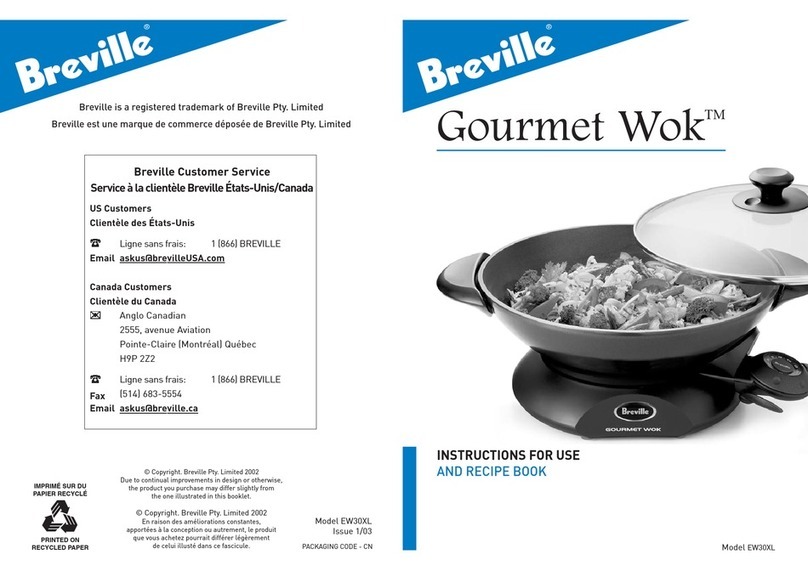
Breville
Breville EW30XL User manual
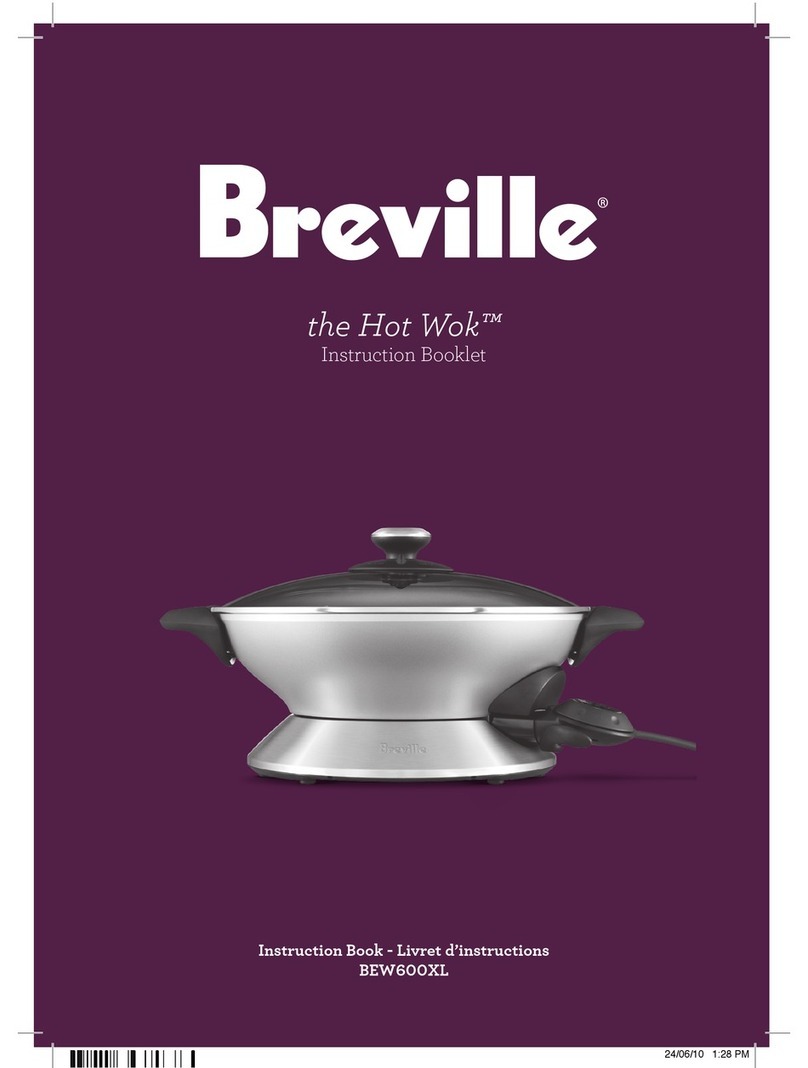
Breville
Breville THE HOT WOK BEW600XL User manual

Breville
Breville EW30XL User manual

Breville
Breville EW40 User manual

Breville
Breville TF40 User manual

Breville
Breville Avance Banquet BEF400 User manual


